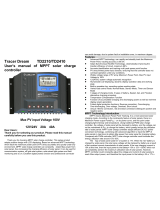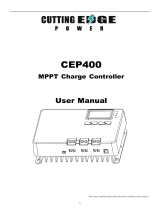Page is loading ...

1
USER MANUAL OF MPPT SOLAR CHARGE CONTROLLER
For Models: S3-30A, S3-40A, S3-50A, S3-60A
Important note
All expressed or written warranties shall be deemed void if controller has been
opened, disassembled, altered or used in any manner inconsistent with written
instructions. All warranties shall also be deemed void if controller is overpowered,
input PV polarity reversed or battery polarity reversed. It’s user’s responsibility to
control input wattage and connect all polarity correctly to avoid damaging controller.
Features
30A/40A/50A/60A MPPT solar charge controller
MPPT technology
Built-in High Performance DSP controller
Automatic battery voltage detection for 12V/24V/36V/48V
3-stage charging optimizes battery performance
The MPPT track speed is 5 times faster than traditional controllers
The charging voltage accuracy is ± 0.2V
Output limited current protection, Overcharge protection, Over-temperature protection
Suitable for battery types such as lead acid, vented gel, and lithium battery, etc
Basic Parameter
Models
S3-30A
S3-40A
S3-50A
S3-60A
Battery voltage automatic recognition
12V system: 9V-15V; 24V system: 18V-29V
36V system: 30V-39V; 48V system: 40V-60V
Overcharging protection voltage
12V Bat: 15V; 24V Bat: 30V;
36V Bat: 45V; 48V Bat: 60V
Limited current protection
31A
42A
51A
61A
Max efficiency
≥98.2%
PV utilization
≥99%

2
Protection function
Temperature protection
75℃ / 167℉
Fan-on temperature
>45℃ / 113℉
Fan-off temperature
<40℃ / 104℉
Properties
Dimensions
214x115x50mm / 8.4*4.5*1.97in
Net weight
1.2KG / 2.65LB
Electromagnetic compatibility
Accord to EN61000, EN55022, EN55024
Enclosure
IP21
Environmental temperature
-20℃ ~ +55℃ / -4℉ ~ + 131℉
Storage temperature
-40℃ ~ +75℃ / -40℉ ~ + 167℉
How to choose PV Module
Models
S3-30A
S3-40A
S3-50A
S3-60A
Maximum PV Module
Input Power
(Never overpowered)
For 12V Battery
≤400W
≤480W
≤600W
≤720W
For 24V Battery
≤720W
≤960W
≤1200W
≤1440W
For 36V Battery
≤1000W
≤1400W
≤1800W
≤2100W
For 48V Battery
≤1200W
≤1700W
≤2200W
≤2800W
PV Module Open Circuit
Voltage
For 12V Battery
DC20V~DC80V
For 24V Battery
DC37V~DC105V
For 36V Battery
DC50V~DC160V
For 48V Battery
DC72V~DC160V
Maximum PV Module Open Circuit Voltage
(Never over max PV Voc)
For 12V Battery: 80V; For 24V battery: 105V;
For 36V battery: 160V; For 48V battery: 160V.
Notes: Voc of PV should be in the correct range and when it’s 1.5 or 2 times than battery voltage,
then it’s best efficiency. Please choose the PV modules with right Voc.

3
How choose Two-pole Circuit Breaker and Wires
Models
S3-30A
S3-40A
S3-50A
S3-60A
Pure copper wires
6mm²/9AWG
6mm²/9AWG
2PCS 6mm²/9AWG
2PCS 6mm²/9AWG
Circuit Breaker
2PCS 63A
2PCS 63A
2PCS 63A
2PCS 100A
Warning
Be aware that only qualified professionals should install these controllers. Please read full
manual before installing. Please don’t set any parameters if you are not a professional
installer. The controller will work well on defaults for Lead acid. Lithium battery require
parameter change.
The controllers should be installed indoors only. Keep controller away from water. Don’t
use wet towel to wipe controller.
Never open the controller case without permission. Never reverse input PV polarity.
Never reverse the battery polarity. Never overpower input PV.
The controller can't connect 110V or 240V or any other AC appliances in the OUT+, OUT-
terminal. The output is only for DC load current less than 5A. If your battery is 48V, then
load should be 48V and current less than 5A.
Must use two-pole circuit breakers, and make sure the input and output are using
separate circuit breakers.
Use the pure copper wires and connect all polarity correctly.
Please don’t insert any meter or other devices between controller and battery or controller
and PV.
It’s important to open terminal lugs 100% before inserting wire into terminal block. Then
tighten and recheck to make sure wires are secure.
Please note that running maximum wattage could be a hazard if atmospheric conditions
allow for PV array to over power unit. There are times that a 2880 rated PV array can
produce in excess of 3400 watts. This can damage controller. It is best to allow room for
that occurance.
Please refer to an awg wire size calculator to properly size your wire from your PV, Battery,
and Inverter. When in doubt, larger size wire is always a better choice.

4
Reminder
The battery voltage must be over 12V, then can start up the controller.
Keep controller in an environmental temperature of -22℃~+55℃. Avoid direct sunlight.
Keep good heat dissipation.
Please contact us or authorized distributor if any doubts before installation or any errors
after installed.
Installation steps
1. Use one two-pole circuit breaker in “OFF” position. Install this circuit breaker between
controller and battery. Connect batteries to controller ensuring correct polarity. Set circuit
breaker to “ON” position. Startup screen will appear with model and version displayed. Set
the controller parameter that you want (See Manual Setting steps) and reboot controller.
Double check the settings to ensure successful. If using lead acid battery, you don’t need
to set the parameter and controller will work well. Controller requires 12V to start up. Turn
“OFF” the circuit breaker.
2. Take another two-pole circuit breaker in “OFF” position. Install this circuit breaker between
controller and PV modules. Make sure the PV polarity is correct, then connect PV wires to
controller PV Input. Ensure all wire connection are stable, if not, damage to CPU will result.
3. Turn “ON” the circuit breaker between controller and batteries, and turn “ON” the circuit
breaker between controller and PV modules.
4. The controller LCD displays the parameters if all is correct.
How to connect diagram
For S3-30A and S3-40A, you can connect one wire to one PV+ and another wire to one PV-.
For S3-50A and S3-60A, please connect two wires to two PV+ and another two wires to two
PV-.
For BAT+ and BAT-, it’s same way to connect wires as above.
( See diagram on next page)

5
How to make controllers in parallel
Controller PV+ Two-pole Circuit breaker+ Solar+
Controller PV- Two-pole Circuit breaker- Solar-
Controller BT+ Two-pole Circuit breaker+ Battery+
Controller BT- Two-pole Circuit breaker- Battery-
Controller OU+ Two-pole Circuit breaker+ DC Load+
Controller OU- Two-pole Circuit breaker- DC Load-
Make sure all wires are same
size and length. Wire resistance
is very important when
installing parallel units and
battery banks

6
LCD display
Working mode
1
PV voltage / Output power
3.0
Night mode, no charging
2
Battery voltage / Charging current
4.0
MPPT mode
3
Working mode/Error code/Temperature
7.0
Absorption mode
4
ACC Power Generation
8.0
Floating mode
Troubleshooting
Code
Description
How to solve
18
Input PV voltage is low
Increase the PV voltage
60
Over-temperature
protection
Fan will work and temperature reduction
automatically
63
Battery voltage is high
Battery high voltage protection and wait for recovery
65
Battery voltage is low
Battery over-discharge and wait for recovery
71
Input PV voltage is
high
Decrease the PV voltage, refer to correct Voc range
73
Over-charging current
Decrease the PV power, refer to correct Voc range
74
Output load is short
Disconnect the load and press ENT over 5 seconds
Manual Setting
Reminder: The controller will work well on default setting except lithium battery.
Caution! Disconnect the PV modules before setting the controller. When you set up all steps,
please reboot the controller to see if all setting is successful.
1. D00 Press the button PRG, then LCD displays D00. This is setting for load working time
(Default is 24-hour). Press ENTER until numbers flash, then press UP/DOWN to set up time
that you want, press ENTER to confirm it. This output voltage is same as battery. The load
is only for small DC load less 5AMP current. If no load, just leave it.
2. D01 Press the button UP, LCD shows 13.8 (Voltage can be set from 12V-17V). This is
default value of floating voltage. Press ENTER until numbers flash, then press UP/DOWN to
set up voltage that you want, press ENTER to confirm it.

7
3. D02 Continue to press the button UP, LCD shows 14.5 (Voltage can be set from 12V-
17V). This is highest constant voltage for battery. Press ENTER until numbers flash, then
press UP/DOWN to set up voltage that you want, press ENTER to confirm it.
4. D03 Continue to press the button UP, LCD shows 10.0. This is protection value of battery
discharge. Press ENTER until numbers flash, then press UP/DOWN to set up voltage that
you want, press ENTER to confirm it. It means it’s protected when 12V battery is less 10.0V
and there is no output power from OU+ and OU-.
5. D04 Continue to press the button UP, LCD shows 00. 00 is default for lead acid batteries.
If it’s for lithium battery, please press ENTER until numbers flash, then press UP/DOWN to
choose 01, press ENTER to confirm it. Step 2 (D01) is not useful when you choose 01 for
lithium battery. And the voltage in step 3 (D02) will be highest charging voltage for lithium
battery. Press ESC to exit the setting menu. Reboot the controller and check settings again.
Dimension
Notes: Please use our screws only since it may damage the internal PCB if using other screws.
Please use proper torque to push the screws into casing since it may damage the internal PCB by
strong torque.
Content Included
1 Controller
1 English manual
4 Corner connections
4 Screws for controller casing

8
Batteries charge voltage reference
Battery
Type
Absorption Voltage ( Constant voltage )
Floating Voltage
12V
24V
48V
12V
24V
48V
Vented
14.2V
28.6V
57.2V
13.2V
26.4V
52.80V
Sealed
14.4V
28.8V
57.6V
13.8V
27.6V
55.2V
Gel
14.4 V
28.8V
57.6V
13.8V
27.6V
55.2V
NiCd
14.2V
28.6V
57.2V
14.0V
28.0V
56.0V
Lithium
Or special
battery
If your battery voltage range is 9-15V, then it's 12V system, you can set
controller charging voltage from 12V-17V.
If 18-29V, then it's 24V system, you can set voltage from 24V-34V.
If 30-39V, then it's 36V system, you can set voltage from 36V-51V.
If 40-60V, then it's 48V system, you can set voltage from 48V-68V.
MakeSkyBlue (Shenzhen) Technology Co., LTD
1402M, Bldg. C6, Hengfeng Industry Zone, Hezhou, Baoan,
Shenzhen Guangdong 518101
China
Tel: 86 755 2331 3263
www.makeskyblue.com
sales@makeskyblue.com
V20190426
/




